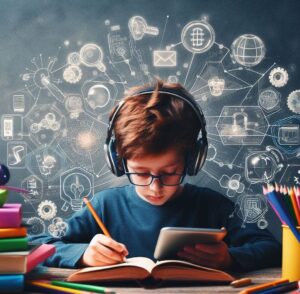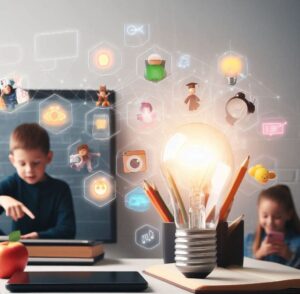Utilization of Social Media and Digital Technology in Education

Social media and digital technology have become a crucial part of modern educational environments. Social platforms and digital applications are being integrated progressively throughout learning institutions around the globe already. These tools are not only reshaping the methodologies and practices of teaching but also redefining students’ learning experiences.
A key component often utilized are digital platforms, such as YouTube. Schools and educators find value in its vast range of informational and instructional content. From documentary-style presentations to simple explanatory animations, YouTube offers video-based knowledge resources applicable on any subject matter. Teachers often use these visual aids to supplement traditional learning materials, illuminating concepts with a depth and dynamism that textbooks might not be able to achieve. For students, YouTube is a familiar and accessible platform where they can independently explore and deepen their understanding of topics at their own pace.
Language learning applications like Duolingo are another component of the digital resources regularly employed in schools. The simplicity and interactivity of such applications have made learning foreign languages more engaging. Duolingo uses games and rewards to make the process of language learning fun and less intimidating as opposed to traditional methods. In addition to use within classrooms, these apps also enable self-driven education, as students can continue to practice and learn on their personal devices outside of school hours.
Social networks, specifically education-focused platforms like Edmodo, are being adopted to strengthen the communication between educators and students, and extend it beyond the confines of the classroom. Teachers can post assignments, provide feedback, share educational resources, and convey important notices through the platform. Students, on the other hand, can submit their work, collaborate with classmates, clear doubts with teachers, and constantly stay in sync with class activities.
One important finding from research underscores the potential impact these resources can have. According to Pew Research Center, 96% of students who have access to the internet report using social media. This prevalence suggests a great opportunity for education systems to leverage these platforms even more extensively in their efforts to engage students in the learning process.
To put it succinctly, the rise of social media and digital technology in the education system is not only transforming the landscape but also democratizing education. By allowing learning to be more interactive, comprehensive, and personalized, digital technology is pushing the boundaries of how education is delivered and experienced.
Positive Impacts
The integration of social media and digital technology in education has resulted in numerous positive impacts. The most significant among these impacts is the democratization of access to information and resources. In the traditional classroom setting, learning was often restricted to the finite information contained within textbooks. But now, with just an internet connection, students can tap into a nearly infinite stream of resources online.
For instance, educational platforms such as YouTube have become the new age learning resource. Students can immerse themselves in illustrative videos, deep dive documentaries, insightful talk series, and more – all at the touch of a button. Furthermore, due to the live-streaming feature, students now have the chance to attend live lectures and webinars from experts worldwide, opening up worldwide learning opportunities without geographical restrictions. Platforms like global student forums serve as virtual melting pots where students from various countries and cultures can collaborate, exchange ideas, learn from one another, and develop a broader, more inclusive perspective.
Another noteworthy benefit of these digital tools in education is the promotion of skill development and personalized learning. Education is no longer a one-size-fits-all model thanks to digital technology. Interactive learning apps and education-based games provide individualized learning journeys that let students advance at their own pace. These platforms provide resources catering to varied learning styles, thereby ensuring that each learner’s unique needs are addressed.
Digital tech tools have revolutionized how students and teachers interact and collaborate. Social media platforms and education apps enhance the learning experience by encouraging active participation while also allowing for immediate feedback and support. For instance, students can easily engage in group projects with their peers, even from the comfort of their homes. They can communicate with their teachers outside of traditional school hours, enabling a constant support system. These platforms also enable real-time feedback, allowing students to rectify errors and learn from them quickly.
Social media and digital technology have become powerful tools in reshaping education, providing numerous benefits including global access to resources, personalized learning, augmented skill development, and improved communication and collaboration. This revolutionary approach to education offers a promising future that is interactive, inclusive, and in sync with the evolving digital world.
Negative Impacts of Social Media and Digital Technology in Education

Despite the immense benefits, the incorporation of social media and digital technology in learning environments has come with its own set of demerits. The most evident of these is the potential for distraction that digital technology carries. Today’s students live in an era of notifications where every incoming message, app alert, or new tab can easily divert their attention. Consequently, staying focused on academic tasks in this media-saturated environment becomes a major challenge. The habitual multitasking associated with digital technology usage can lead to inefficient learning and lower academic performance.
Another critical issue brought to light by the digital revolution is the higher susceptibility to cyberbullying. With increasing online interactions, advanced technology, and anonymous platforms, incidences of cyberbullying have indeed seen a steady rise. According to the Cyberbullying Research Center, a staggering 36.5% of U.S students have encountered cyberbullying at some point. These incidents can lead to severe psychological trauma and can notably affect a student’s academic performance and overall well-being.
The issue of the ‘digital divide’ poses a significant challenge for educational institutions. This term refers to the disparities in access to technology or high-speed Internet amongst the student population. A 2018 survey by Pew Research Center reveals that nearly one-in-five teenagers sometimes cannot complete their homework due to a lack of a reliable computer or internet connection. This inequality in access to necessary tools not only affects academic performance but also threatens to widen the gap in future opportunities and career trajectories for disadvantaged students.
Although social media and digital technology have revolutionized education by enhancing accessibility, personalizing learning, and facilitating communication, it’s crucial to address the associated challenges? Issues like digital distraction, cyberbullying, and the digital divide need appropriate interventions and policies to ensure that the digital revolution in education leads to a fair, safe, and focused learning environment.
Solutions and Policies
Effective strategies and policies can mitigate these issues. Schools can integrate digital literacy and cyber safety programs to teach students about safe and responsible online behavior. Furthermore, using focused digital learning methods can leverage technology for improved academic outcomes while also managing screen time effectively. To address the digital divide, governments and technology companies can partner to provide reliable internet and device access for all. NGOs can also play a key role in ensuring that every child benefits from the digital age, regardless of their socioeconomic background.
Social media and digital technology are profoundly impacting children’s education, bringing both unprecedented opportunities and new challenges. As this trend continues to expand, it’s essential to address these issues proactively to ensure that all students reap the benefits of a digital education, now and in the future.

